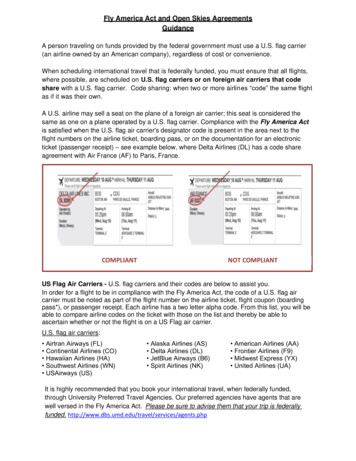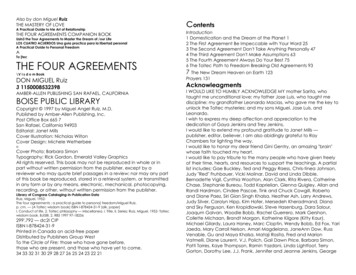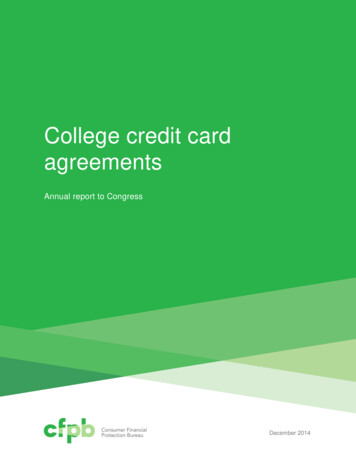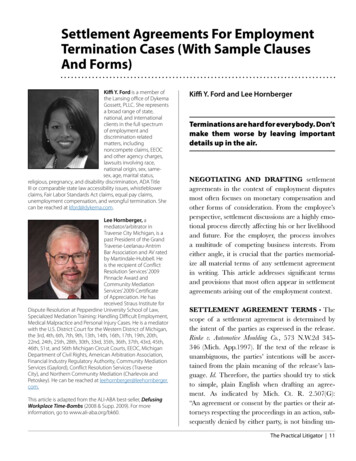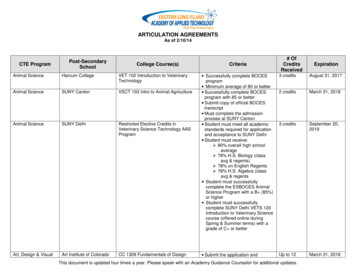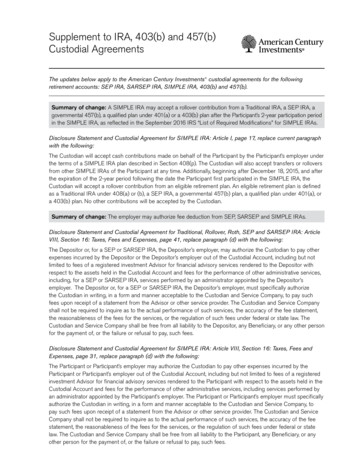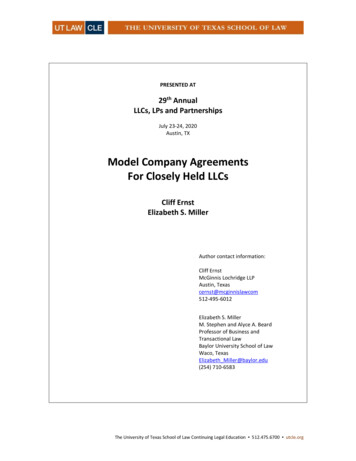
Transcription
PRESENTED AT29th AnnualLLCs, LPs and PartnershipsJuly 23-24, 2020Austin, TXModel Company AgreementsFor Closely Held LLCsCliff ErnstElizabeth S. MillerAuthor contact information:Cliff ErnstMcGinnis Lochridge LLPAustin, Texascernst@mcginnislawcom512-495-6012Elizabeth S. MillerM. Stephen and Alyce A. BeardProfessor of Business andTransactional LawBaylor University School of LawWaco, TexasElizabeth Miller@baylor.edu(254) 710-6583The University of Texas School of Law Continuing Legal Education 512.475.6700 utcle.org
Model Company AgreementsFor Closely Held LLCsTable of ContentsPageI.Introduction . 1II.Company Agreements Generally . 2III.The Model Agreements. 3IV.A.Introductory Paragraph . 3B.Article 1: Formation. 5C.Article 2: Members and Membership Interests . 6D.Article 3: Management of the Company, Meetings and Voting . 17E.Article 4: Capital Contributions. . 23F.Article 5: Taxation and Allocations. . 26G.Article 6: Distributions . 27H.Article 7: Bank Account, Books of Account, Reports and Fiscal Year . 28I.Article 8: Transfer Restrictions and Push Pull Provisions . 31J.Article 9: Exculpation, Scope of Duties, Indemnification and Advancement . 33K.Article 10: Winding Up . 44L.Article 11: Miscellaneous Provisions and Definitions. 46Conclusion . 48Appendix A – Model Company Agreement for Manager-Managed, Multi-Member Limited LiabilityCompanyAppendix B – Model Company Agreement for Member-Managed, Multi-Member Limited LiabilityCompanyAppendix C – Model Company Agreement for Single Member Limited Liability Companyi
Model Company AgreementsFor Closely Held LLCsCliff ErnstMcGinnis Lochridge LLPAustin, TexasElizabeth S. MillerM. Stephen and Alyce A. Beard Professorof Business and Transactional LawBaylor Law SchoolWaco, TexasI.Introduction.Records maintained by the Texas Secretary of State indicate that the limited liability company hasbecome the entity of choice among Texas organizations. The office of the Texas Secretary of State reportsthat of the 222,112 certificates of formation filed for domestic for-profit entities in 2018, 192,284 (orapproximately 87%) were limited liability companies, and of the 231,677 certificates of formation filed fordomestic for-profit entities in 2019, 204,065 (or approximately 88%) were limited liability companies. 1It is often stated that one of the benefits of organizing an entity as a limited liability company isthat this form of entity offers the owners and governing authority of the entity the flexibility to agree toprovisions for the economic terms and governance that are more flexible than available with respect to acorporation. This is true, and indeed limited liability companies are sometimes used to create highlycomplex structures with multiple classes of ownership interests and highly customized provisions regardingmanagement and governance of the entity, including complicated provisions for voting and managementsuccession. However, given the large number of entities now being created as limited liability companiesin Texas and other states, it is likely that many of these new entities are not entities with complex structureswith multiple classes of ownership and complex bureaucracies for governance. Statistics compiled by theInternal Revenue Service show that for the tax years 2015 and 2016 (the most recent years for whichstatistics are currently available), approximately 65% of the S corporation returns are for single-shareholderS corporations and approximately 26% have only two shareholders. 2 The Internal Revenue Service doesnot publish similar statistics for limited liability companies, and of course single-member limited liability1The office of the Texas Secretary of State has provided to the authors the following information aboutnumbers of certificates of formation and initial LLP registrations filed for domestic entities:For-Profit CorporationsProfessional CorporationsProfessional AssociationsLimited Liability CompaniesLimited PartnershipsLimited Liability 122580307204,0654,603364Table 9: Returns of Active Corporations, Form 1120S (2015) (2016), available poration-complete-report21
companies are typically disregarded entities that do not file tax returns. But if one assumes that most limitedliability companies are closely held entities, then by analogy, it is likely that a large portion of limitedliability companies have one or two owners. Therefore, it is much more likely that practitioners will findthemselves needing to draft simple limited liability company agreements suitable for entities with one ortwo or a very few owners, rather than more complex documents.The purpose of this paper is to present and discuss models for governing agreements for limitedliability companies when a simple structure is needed.II.Company Agreements Generally.As with other filing entities under the Texas Business Organizations Code (“BOC”), 3 a Texaslimited liability company is created by the filing of a certificate of formation meeting the requirements ofBOC §3.005 and §3.010. The existence of the company commences when the filing of the certificate takeseffect as provided in BOC Chapter 4. 4The BOC does not expressly require that a Texas limited liability company have a companyagreement, but it is difficult to conceive of a situation in which there would not be some skeletal agreementof the members regarding the conduct and affairs of the limited liability company. 5 The statute expresslyrecognizes that a company agreement may be written or oral. 6 However, it is obviously advisable for alimited liability company to have a written company agreement to provide certainty and avoid ambiguityabout the ownership and management of the entity.It should be noted that in the event of a conflict between the language of the certificate of formationand the company agreement, the language of the certificate of formation will govern.7 Most practitionershave moved away from the practice of including long substantive provisions in the certificate of formation,and indeed many are comfortable using the simple form of certificate promulgated by the Secretary ofState. 8 In the past it was more common to address issues such as indemnification or written consents inlieu of meetings in the filing made with the Secretary of State. Since the owners of the entity do not needto sign the certificate and may not see or focus on substantive provisions in the certificate, care should begiven that any such provisions do not unintentionally override the provisions of the company agreement.3TEX. BUS. ORGS. CODE ANN. § 1.001 ET SEQ.4TEX. BUS. ORGS. CODE ANN. § 3.001(c).Inasmuch as the BOC recognizes oral as well as written company agreements, a course of dealing may reflectthe company agreement of the members on some matters. Furthermore, any provision that may be contained in thecompany agreement may be included in the certificate of formation. TEX. BUS. ORGS. CODE ANN. § 101.051(a). Evena very basic certificate of formation would seemingly constitute a company agreement as to certain items, such as thename of the company, the type of management (i.e., member-managed or manager-managed), and the identity of theinitial members or managers.56TEX. BUS. ORGS. CODE ANN. § 101.001(1) (defining “company agreement” as “any agreement, written ororal, of the members concerning the affairs of a limited liability company”).TEX. BUS. ORGS. CODE ANN. § 101.052(d). See Pinnacle Data Servs., Inc. v. Gillen, 104 S.W.3d 188 (Tex.App.—Texarkana 2003, no pet.) (holding voting provision in limited liability company’s articles of organizationcontrolled over conflicting voting provision contained in the company’s regulations). Because BOC § 101.052(d) isnot listed among the provisions that cannot be waived or modified in the company agreement, the statute arguablypermits the members to provide in the company agreement (or certificate of formation) that the company agreementcontrols over a conflicting provision in the certificate of formation. See TEX. BUS. ORGS. CODE ANN. § 101.051,101.052, 101.054.78http://www.sos.state.tx.us/corp/forms boc.shtml.2
III.The Model Agreements.A.Introductory Paragraph.As with almost all agreements, the introductory paragraph of a company agreement typically statesthe parties to the agreement and the date or effective date of the agreement. The members of the limitedliability company are always parties to the company agreement.Generally, even in a manager-managed limited liability company whose certificate of formationdoes not identify the initial members, the identities of one or more initial members will be understood atthe time a limited liability company is formed, and it is prudent for the initial members to execute a writtencompany agreement prior to or contemporaneously with the filing of the certificate of formation so that itis clear who the members are and what their economic and governance rights are. The BOC expresslyrecognizes, however, the formation of a limited liability company that does not initially have any members,sometimes referred to as a “shelf” limited liability company. Under this provision, an organizer may file acertificate of formation that identifies one or more initial managers, but the limited liability company neednot have any members for a “reasonable period” after the limited liability company is formed. 9While it is possible to utilize a “shelf” limited liability company, there are some questionsassociated with such a practice. First, what is a “reasonable period” after the filing of the certificate offormation? Is it merely a temporal concept or does it also relate to the activities undertaken by the limitedliability company? Presumably, the managers may undertake certain actions to facilitate the organizationof the limited liability company and securing of investors, but it would be unwise to transact significantbusiness prior to the admission of members. What is the tax classification of a limited liability companywithout members? If the limited liability company undertakes any significant business and there is then afailure to obtain members or a dispute as to whether there are members and who they are, this could be athorny situation.At the point that there are persons who desire to be members in a limited liability company that haspreviously been formed but has no members, may they simply execute a company agreement identifyingthemselves as the members and thereby become members “in connection with the formation” of the limitedliability company? It would appear so, but what if there is a dispute as to who the members will be, i.e., afight over the limited liability company? If two factions each execute a company agreement claiming to bethe members, who determines which is the company agreement of the limited liability company? Inasmuchas becoming a member “in connection with the formation of the limited liability company” when one is notnamed as an initial member in the certificate of formation depends upon a reflection of the person’smembership in a limited liability company “record,” 10 it appears that the manager or managers may have arole in determining which company agreement is the company “record” of membership.If after the filing of the certificate of formation of a limited liability company a substantial periodof time elapses without the admission of members, the question might arise whether a person who desiresto become a member must do so in accordance with the statutory procedures applicable “after the9TEX. BUS. ORGS. CODE ANN. § 101.101(b) (stating that a limited liability company that has managers is notrequired to have members during a “reasonable period between the date the company is formed and the date the firstmember is admitted to the company”). See also TEX. BUS. ORGS. CODE ANN. § 101.356(e) (providing that memberapproval is not required for an action during the reasonable period that a manager-managed limited liability companyis permitted not to have any members after formation).10TEX. BUS. ORGS. CODE ANN. § 101.103(b).3
formation” of the limited liability company. This result would be problematic because the statute requiresthat a person becoming a member after formation of the limited liability company must do so with theconsent of all members unless a company agreement provides otherwise. 11 It would be impossible to admita member under such circumstances because the limited liability company has no members and thus nocompany agreement. 12 It is more logical to interpret the statute as permitting persons to become members“in connection with the formation” of the limited liabi
McGinnis Lochridge LLP Austin, Texas . cernst@mcginnislawcom 512-495-6012 Elizabeth S. Miller M. Stephen and Alyce A. Beard Professor of Business and Transactional Law Baylor University School of Law Waco, Texas . Elizabeth_Miller@baylor.edu (254) 710-6583. i . Model Company Agreements . For Closely Held LLCs . Table of Contents . Page . I. Introduction . 1 . II. Company Agreements .





